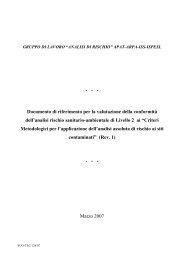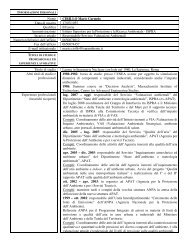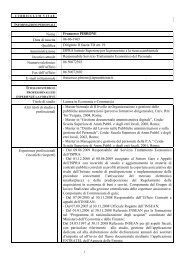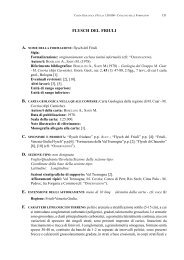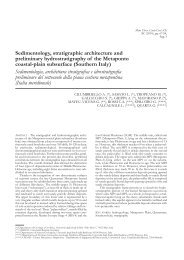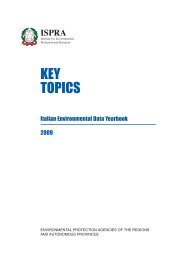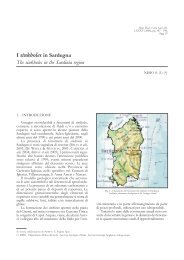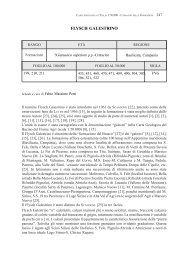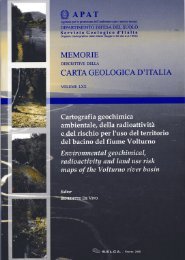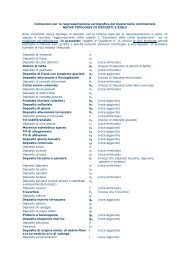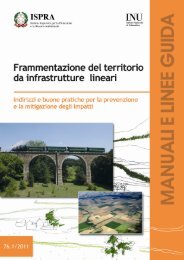Guidebook - Ispra
Guidebook - Ispra
Guidebook - Ispra
You also want an ePaper? Increase the reach of your titles
YUMPU automatically turns print PDFs into web optimized ePapers that Google loves.
Volume n° 1 - from PR01 to B15<br />
B12<br />
B12 -<br />
Leader: M. Sandulescu<br />
calcareous flysch, with turbiditic two- and three-component<br />
rhythms (limy sandstone / marls, silty marls<br />
/ marly limestones, limy sandstones / marls / marly<br />
limestones), 25-75 cm thick. The sandstones are polymictic,<br />
the marly limestones are pelagic, micritic,<br />
containing Tintinnides at different levels. Generally,<br />
taking into account the whole Ceahlău Nappe, the<br />
Sinaia Formation can be divided into three members.<br />
The lower one is dominantly pelitic (marls and siltic<br />
marls) with inlayerings of marly pelagic limestones<br />
and scarce sandstones. In the limestones Calpionella<br />
alpina (frequent) and C.elliptica were found, the<br />
age considered as Tithonian. The median member<br />
shows the typical lithofacies of the Sinaia Formation<br />
(see above) and represents 75-80% of its thickness.<br />
The presence of Calpionella elliptica, Tintinopsella<br />
carpathica, Calpionellites div.sp. was determined,<br />
supporting the Berriasian-Valanginian age. The Upper<br />
Member , Hauterivian in age (with Peregrinella<br />
peregrina), is represented by a two-component flysch<br />
(limy sandstones and dark coloured marls) characterized<br />
by inlayerings of limy polymictic breccias (meso-<br />
and epizonal metamorphics, Triassic and/or Jurassic<br />
dolomites and limestones, quartzitic sandstones). The<br />
Sinaia Formation shows frequent diaclases filled with<br />
calcite and also some zones of schistosity.<br />
Stop 2.3:<br />
Ugra Formation at Săvinești locallity.<br />
The Barremian-Aptian formations of the Ciuc Digitation<br />
are represented by a turbiditic and fluxoturbiditic<br />
sandy flysch – the Ugra Formation. In the 30-150 cm<br />
thick, two-component rhythms, sandstones (65-90 %)<br />
prevail over marls or silty marls. The arenitic material<br />
is polymictic (subgreywacke-type) (quartz and<br />
quartzites, meso- and epizonal metamorphics, Triassic<br />
and Jurassic limestones and dolomites, as well as<br />
mafics and ultramafics) its source area being situated<br />
inward relative to the sedimentary trough.<br />
Downstream of Săvinești near Topliceni the field trip<br />
enters the Durău Digitation, external in respect to the<br />
Ciuc one. The specific formations of this sub-unit of<br />
the Ceahlău Nappe, above the Sinaia Formation, are<br />
the Piscu cu Brazi Formation and the Ceahlău Conglomerates.<br />
Stop 2.4:<br />
Piscu cu Brazi Formation at Poiana Teiului.<br />
On the right-hand bank of the Bistriţa River, 1 km upstream<br />
of the large viaduct from Poiana Largului, and<br />
also on the western bank of (antropic) Bicaz Lake,<br />
the Piscu cu Brazi Formation crops out. It is a twocomponent<br />
flysch, with rhythms 10-50 cm thick. The<br />
sandstones are polymictic (same composition as the<br />
Ugra sandstones – see above), the pelitic component<br />
is marly or silty marly. Toward its upper part the Piscu<br />
cu Brazi Formation grows more massive with 0.5-1.5<br />
m of sandstone (Poiana Maicilor Sandstones). The<br />
age of the Piscu cu Brazi Fm. is Barremian-Aptian according<br />
to the different ammonitic faunas recorded at<br />
different levels (fide Săndulescu, 1990). The Poiana<br />
Maicilor Sandstones are developed in the Upper Aptian.<br />
The youngest formation of the Durău Digitation<br />
are the Albian Ceahlău Conglomerates, which built<br />
up the Ceahlău Mts., visible south of Bicaz Lake.<br />
At Poiana Teiului a calcareous isolated rock is situated<br />
at the northern end of Bicaz Lake (near the viaduct). It<br />
is built up of Urgonian limestones with Pachyodonta<br />
and Orbitolina (Barremian-Lower Aptian) and represents<br />
a tectonic slice, pulled out from the outer margin<br />
of the Outer Dacidian trough – the Peri-Moldavian<br />
Cordillera - and transported to the base of the Ceahlău<br />
Nappe. From Poiana Teiului the fieldtrip proceeds<br />
along the north-eastern slope of Bicaz Lake.<br />
Stop 2.5:<br />
Frontal contact of the Ceahlău Nappe / Convolute<br />
Flysch Nappe.<br />
About 4 km downstream from the Poiana Teiului<br />
viaduct, the fieldtrip reaches the erosional contour<br />
of the tectonic contact between the outernmost part<br />
of the Ceahlău Nappe and the youngest formations<br />
of the Convolute Flysch Nappe. Massive micaferous<br />
sandstones representing the outermost sub-unit of the<br />
Ceahlău Nappe (? the Bodoc Digitation) is overthrust<br />
above the Upper Convolute Flysch Member (twocomponent<br />
turbiditic rhythms, 10-20 cm, with more<br />
or less frequent inlayerings of red marls). The age of<br />
this lower sequence of the Upper Convolute Flysch<br />
Member is Vraconian-Cenomanian; in some other<br />
areas of the East Carpathians, where this Member<br />
is fully developed, the micropaleontological assemblages<br />
specified a Vraconian-Lower Senonian age<br />
(Săndulescu J., 1976; Antonescu and Săndulescu,<br />
1985; Săndulescu et al., 1993).<br />
Stop 2.6:<br />
Cotumba Sandstone and Leţești Conglomerates.<br />
About 1.6 km downstream along the national<br />
route, massive sandstones with conglomerates and<br />
microconglomerate intercalations crop out. The massive<br />
sandstones represent the Cotumba Sandstone



